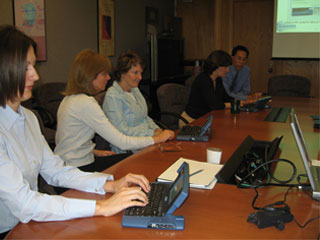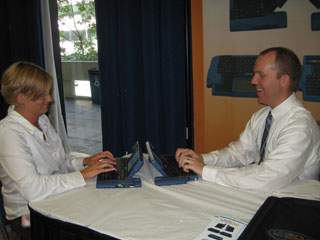
NIDCD-funded Communication Tool Gives Deaf and Hearing People Something to Talk About

NIDCD staff members get their hands on the UbiDuo.
Jason Curry is a people person. The minute you shake hands with him, he makes you feel at home—asking questions, cracking jokes, and sharing amusing stories about himself and his wife Missy. But this amiable 37-year-old from Independence, Mo., hasn’t always been so talkative with everyone he meets. Deaf since birth, Curry has struggled for much of his life to find a way to communicate face-to-face with his hearing friends, family, classmates, instructors, coworkers, clients, and supervisors, not to mention waiters, bank tellers, taxi drivers, and store clerks.
“Let me ask you this question,” he said two or three minutes into our interview. “How important is it for hearing people to strike up a conversation with another hearing person?” He waited a beat for his question to sink in, and then answered it himself. “It is what makes the world go around. And deaf people don't have that power to strike up a conversation face-to-face with [a] hearing person.”
Generally, face-to-face communication between hearing and deaf people is accomplished using sign language, handwritten notes and text messages, or a sign language interpreter. Some software programs are able to translate English into American Sign Language and back again, however, many of these programs are still in the developmental stages.
It was Curry’s desire to really communicate with hearing people that led him to devote most of his free time to the creation of a product that would help get hearing and non-hearing people talking. With the assistance of two Small Business Innovation Research (SBIR) grants from the NIDCD, that product —called the UbiDuo—debuted this past January.

Jason Curry and an employee, Lynn Garretson, demonstrate the UbiDuo.
The Ubi What Now?
The UbiDuo is a device that consists of two keyboards and screens—kind of like a laptop, but a lot lighter (it weighs six pounds total) and without the need for an operating system or special software. One person sits with his keyboard while a second person sits with hers and the conversation takes off from there, with both people typing out what they want to say in real time. As with audible conversations, the discussion can be fast and interruptive, since the words you type appear immediately on the other person’s screen without your needing to hit the send key. Unlike audible conversations, the result is a transcript that can be saved and downloaded for later review—such as after a doctor’s appointment, a business meeting, or, in this case, an interview for a newsletter article. When you’re done talking, the keyboards are latched together side-by-side, folded up, and slipped into a case. The rechargeable batteries last roughly as long as the typical workday.
As with many inventions, the idea had inauspicious origins—after a discussion over eggs and coffee at the local pancake house between Curry and his father, David, who is admittedly weak at sign language.
“We were trying to converse with each other as we ate our breakfast,” explained Curry. “Then Dad said, ‘I am so frustrated trying to talk to you like I do with my other sons who are hearing.’ So we both got up and headed home. Then Dad drew this design of the UbiDuo on the white board and when I saw that drawing, I screamed at the top of my lungs and said, ‘that is going to change the world for millions of deaf and hard-of-hearing people.’”
Curry, who has a bachelor’s degree from Central Missouri State University (now the University of Central Missouri), and a remarkable head for business, set out to make his dad’s sketch reality. He received $100,000 from the NIDCD to test the feasibility of such a product by jury-rigging two laptops together to find out if they improved face-to-face communication between deaf and hearing people. He and his research team also asked the tester-participants what they wanted to see in a communication device and incorporated those ideas into their prototype. In 2005, he received a second grant from NIDCD for $1.3 million for the development of what is now called the UbiDuo. “Ubi” is derived from the word ubiquitous—it can be used anywhere—and “Duo” refers to the fact that one device facilitates a conversation between two people.
Curry notes that two UbiDuos can be integrated so that four or more people can take part in a team meeting. And even though it was primarily designed for face-to-face communication, the UbiDuo can be used over phone lines in place of a TTY machine—also in real time and allowing up to four people to converse simultaneously. Other features he hopes to add over time are a Braille reader, speech output, translation to foreign languages, and a camera to capture a user’s face in live video.
In 2006, Curry’s company sComm was awarded the Governor's Technology Company of the Year by the Missouri Department of Economic Development in recognition of the UbiDuo.
As for how his product has changed his life so far, Curry smiles.
“My wife, who is hearing, and I have been married 13 years. For 18 years, when I went to her mother's house for Christmas, I would sit in the living room, kind of left out. Just this Christmas, I was able to sit in the living room and chat with Missy's brother for three long hours.”
He added, “I have my UbiDuo on the desk all day long and hearing people simply walk in and sit down, then start talking to me. I no longer depend on an interpreter.”
Top